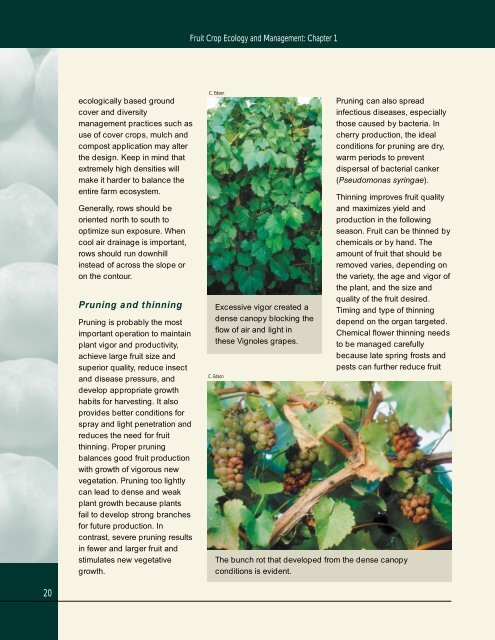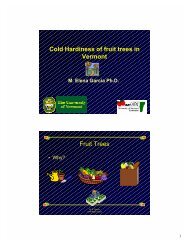Fruit Crop Ecology and Management - UVM Apple Orchard
Fruit Crop Ecology and Management - UVM Apple Orchard
Fruit Crop Ecology and Management - UVM Apple Orchard
Create successful ePaper yourself
Turn your PDF publications into a flip-book with our unique Google optimized e-Paper software.
20<br />
ecologically based ground<br />
cover <strong>and</strong> diversity<br />
management practices such as<br />
use of cover crops, mulch <strong>and</strong><br />
compost application may alter<br />
the design. Keep in mind that<br />
extremely high densities will<br />
make it harder to balance the<br />
entire farm ecosystem.<br />
Generally, rows should be<br />
oriented north to south to<br />
optimize sun exposure. When<br />
cool air drainage is important,<br />
rows should run downhill<br />
instead of across the slope or<br />
on the contour.<br />
Pruning <strong>and</strong> thinning<br />
Pruning is probably the most<br />
important operation to maintain<br />
plant vigor <strong>and</strong> productivity,<br />
achieve large fruit size <strong>and</strong><br />
superior quality, reduce insect<br />
<strong>and</strong> disease pressure, <strong>and</strong><br />
develop appropriate growth<br />
habits for harvesting. It also<br />
provides better conditions for<br />
spray <strong>and</strong> light penetration <strong>and</strong><br />
reduces the need for fruit<br />
thinning. Proper pruning<br />
balances good fruit production<br />
with growth of vigorous new<br />
vegetation. Pruning too lightly<br />
can lead to dense <strong>and</strong> weak<br />
plant growth because plants<br />
fail to develop strong branches<br />
for future production. In<br />
contrast, severe pruning results<br />
in fewer <strong>and</strong> larger fruit <strong>and</strong><br />
stimulates new vegetative<br />
growth.<br />
<strong>Fruit</strong> <strong>Crop</strong> <strong>Ecology</strong> <strong>and</strong> <strong>Management</strong>: Chapter 1<br />
C. Edson<br />
Excessive vigor created a<br />
dense canopy blocking the<br />
flow of air <strong>and</strong> light in<br />
these Vignoles grapes.<br />
C. Edson<br />
Pruning can also spread<br />
infectious diseases, especially<br />
those caused by bacteria. In<br />
cherry production, the ideal<br />
conditions for pruning are dry,<br />
warm periods to prevent<br />
dispersal of bacterial canker<br />
(Pseudomonas syringae).<br />
Thinning improves fruit quality<br />
<strong>and</strong> maximizes yield <strong>and</strong><br />
production in the following<br />
season. <strong>Fruit</strong> can be thinned by<br />
chemicals or by h<strong>and</strong>. The<br />
amount of fruit that should be<br />
removed varies, depending on<br />
the variety, the age <strong>and</strong> vigor of<br />
the plant, <strong>and</strong> the size <strong>and</strong><br />
quality of the fruit desired.<br />
Timing <strong>and</strong> type of thinning<br />
depend on the organ targeted.<br />
Chemical flower thinning needs<br />
to be managed carefully<br />
because late spring frosts <strong>and</strong><br />
pests can further reduce fruit<br />
The bunch rot that developed from the dense canopy<br />
conditions is evident.



